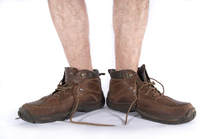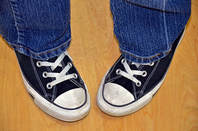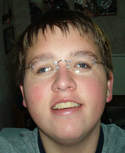
WHAT IS AN EYE TURN?
You may have heard Dr. Henshaw refer to your condition as a “wandering eye.” In this brochure we will give you the technical term. You may have either exotropia or exophoria. Let’s see what those terms mean.
You may have heard Dr. Henshaw refer to your condition as a “wandering eye.” In this brochure we will give you the technical term. You may have either exotropia or exophoria. Let’s see what those terms mean.
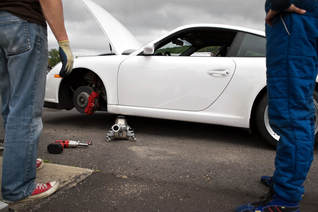
Just as the wheels of a car must be aligned so must your eyes. When the wheels are out of alignment, the tires become worn. Often wear and tare also takes place in other parts of the car. When your eyes aren't properly aligned, you experience eyestrain and strain in other parts of your body.
Two types of eye miss-alignment exist. One is a tropia and the other is a phoria. Phoria means a tendency to miss-align an eye that you can control. Tropia means a miss-alignment that you cannot control. Your car cannot compensate for wheels that turn in or out. That would be like a tropia. Our eyes can compensate for a tendency to turn in or out. The eye muscles work just a little bit harder to pull the eyes into alignment. That would be a phoria
Two types of eye miss-alignment exist. One is a tropia and the other is a phoria. Phoria means a tendency to miss-align an eye that you can control. Tropia means a miss-alignment that you cannot control. Your car cannot compensate for wheels that turn in or out. That would be like a tropia. Our eyes can compensate for a tendency to turn in or out. The eye muscles work just a little bit harder to pull the eyes into alignment. That would be a phoria
Eye teaming difficulty usually includes body teaming difficulty (the two halves of the body do not work as a coordinated team). It is common for an exophore's foot to turn out or an esophore's foot to turn in.
The exophore is more interested in things further away in space and is an outdoors person. An exophore doesn't take things too personally. The esophore is more interested in things closer in space and is an indoors person. An esophore does take things personally.
The exophore is more interested in things further away in space and is an outdoors person. An exophore doesn't take things too personally. The esophore is more interested in things closer in space and is an indoors person. An esophore does take things personally.

Does the personality cause the vision condition or the vision condition cause the personality? More important, you can change the vision condition. Once the vision is changed, it is no longer difficult for an exotrope to view things closer in space and for the esotrope to view things further away in space. Many characteristics often thought to be personality traits are really symptoms of a vision problem and can be changed. The personality really is not changing; but what people previously thought was a personality trait, was the symptom of a vision condition.
By treating eye miss-alignment you can become more efficient and comfortable in almost all you do.
By treating eye miss-alignment you can become more efficient and comfortable in almost all you do.

EXOPHORIA/EXOTROPIA CHARACTERISTICS
01. You like the outdoors and mountains.
01. You like the outdoors and mountains.

02. You work very hard at all things.

03. You "crash" when the job is done.

04. You need to get away for the weekend.

05. Others around you, only after the job is done, especially your family, consider you lazy as they only see you in the crash phase.

06. Getting to sleep is difficult as you tend to think about the next day's plans.

07. You are more comfortable in loose fitting clothes. You dislike ties or chokers.

08. Your interests are varied but not deep.

09. You are strong-willed once you make a decision but have difficulty determining what decision to make. Remember, strong willed can include patriotism, commitment, compassion, and dedication, not just stubborn.

10. Your strength in planning is the main idea and the big picture. (This varies if you are nearsighted.)

11. Planning the future is a strength. Reconstructing the past is difficult. (This varies if you are nearsighted.)

12. If nearsighted, you are sensitive; but more to others needs than your own.

13. You let very few if anyone close to you.

14. You hit golf balls, etc. too hard or take the outside shot in basketball.
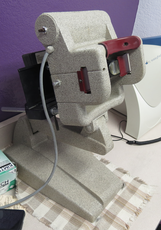
WHAT IS THE FIRST STEP?
Diagnostic testing helps Dr. Henshaw determine if your condition can be treated and which method of treatment would be best for you. It also demonstrates your vision problem to you. You may bring an observer, usually a spouse, whom you wish to understand your vision condition. For children we insist that at least one parent observe.
But how about those people who, for varied reasons, are not ready to change their vision condition. Following are some hints for making life easier.EXOPHORIA / EXOTROPIA HINTS
Diagnostic testing helps Dr. Henshaw determine if your condition can be treated and which method of treatment would be best for you. It also demonstrates your vision problem to you. You may bring an observer, usually a spouse, whom you wish to understand your vision condition. For children we insist that at least one parent observe.
But how about those people who, for varied reasons, are not ready to change their vision condition. Following are some hints for making life easier.EXOPHORIA / EXOTROPIA HINTS

01. Sit catty-corner at the table with your spouse rather than across from each other unless the table is long.

02. Sit with your back to the wall in a restaurant unless the wall contains a window.

03. Position yourself so others sit or stand to your side.

04. Tight spaces like crowded elevators bother you. Get to the back of the elevator in a crowd if you are tall. If not, close your eyes and visualize looking off a mountain top.

05. Segment reading and close work with breaks.

06. Momentarily focus on the distance before and during reading.
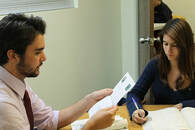
07. Seek others’ aid in sorting details.

08. Be careful of people's feelings. You are less sensitive than others.

09. Remember to shut doors gently or you may slam them.

10. Do not make snap decisions unless very familiar with the subject. Let others know you will get back later.
11. Be certain shirt collars have ample room especially if you wear a tie.

12. Bifocals may be a difficult adaption. Give them time.

13. Have your glasses adjusted often. You remove them frequently which can miss-align them.
REMEMBER, EXCEPTIONS TO THESE GUIDELINES ALWAYS EXIST
REMEMBER, EXCEPTIONS TO THESE GUIDELINES ALWAYS EXIST
If you would like to look at a PDF of Exophoria click below.
| exophoria.pdf |

The Dog Walking Problem (An explanation of eyes that turn outward for women who may not relate to automobile alignment.)
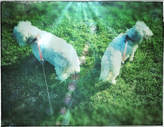
You turn your eyes in an outward direction, as if trying to walk two dogs running in the opposite direction.. The turn could be a tendency to turn which you control, technically called exophoria or an actual turn you can't control called exotropia.
Watch the video below about the dog walking problem
Watch the video below about the dog walking problem

The Front End Alignment Problem (For men who can relate to automobile alignment.) Many women are not aware of the front end of a car so I use the dog walking comparison, while for the men I use the front end alignment.

You turn your eyes in an outward direction like a car's front end towing out. The turn could be a tendency to turn which you control, technically called exophoria or an actual turn you can't control called exotropia.
Watch the video below to learn about how you uses your eyes.
Watch the video below to learn about how you uses your eyes.


